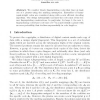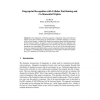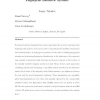9 search results - page 1 / 2 » On the Assumption of Equal Contributions in Fingerprinting |
TIFS
2008
13 years 4 months ago
2008
With a digital fingerprinting scheme a vendor of digital copies of copyrighted material marks each individual copy with a unique fingerprint. If an illegal copy appears, it can be ...
CODCRY
2009
Springer
13 years 11 months ago
2009
Springer
We consider binary fingerprinting codes that trace at least one of t pirates using the marking assumption. Ensembles of binary equal-weight codes are considered along with a new e...
BIOSIG
2010
13 years 2 months ago
2010
: In this fingerprint verification approach, a fingerprint image is divided into equally sized cells and the pattern is represented by a substitute resulting in a feature vector of...
PRL
2007
13 years 4 months ago
2007
Securing biometrics databases from being compromised is one of the most important challenges that must be overcome in order to demonstrate the viability of biometrics based authen...
CF
2010
ACM
13 years 8 months ago
2010
ACM
Cache memories currently treat all blocks as if they were equally important, but this assumption of equally importance is not always valid. For instance, not all blocks deserve to...



